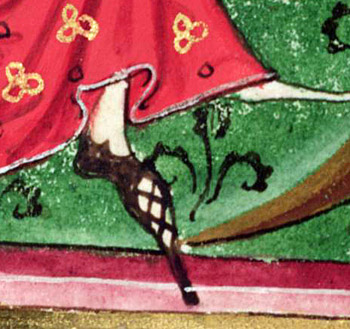Sir Orfeo
General Information
(N)IMEV: 3868
Form: Short couplets
Date of Composition: Late thirteenth or early fourteenth century
Place of Composition: Westminster-Middlesex area
Keywords: Disguise, Dreams, Exile, Forest, Other-world, Steward, Supernatural, Tokens of Recognition
Plot Summary

After an introduction on the Breton Lay, the poem introduces Sir Orfeo, an English king who is also a skilled harpist. One day in May, his wife Herodis falls asleep under a grafted tree in their orchard. When she awakes, she begins to scream and claw her face; the king of the fairies has visited her and demanded that she live with him forever. If she does not go willingly, she will be violently attacked and carried away. Orfeo gathers his knights, but the queen disappears from their midst.
Telling his men that they must choose a new king, the distraught Orfeo takes his harp and begins to wander in the wilderness. He lives on the heath for ten years, in stark contrast to his former life. He often sees the king of fairies and his retinue, hunting and dancing. On one occasion he sees Herodis, but the fairies take her away before the pair can speak. Orfeo follows them through a cave and into a beautiful landscape with a bejewelled castle. Claiming to be a minstrel, he gains access to the castle, where he sees all the people taken by the fairies, including his wife. He enters the hall and plays his harp for the fairy king, who is so charmed by his music that he offers him a reward of his choice. Orfeo requests Herodis and, although the king objects, Orfeo holds him to his promise.
The couple return to Winchester, still in disguise. Orfeo approaches his steward, who welcomes the harpist in honour of his former king. When he plays, the steward recognises the harp, but Orfeo tells him that he found it beside a dead man. The steward shows his loyalty by weeping, so Orfeo reveals his identity and makes his steward his heir. The court rejoice and re-crown their king, while the harpers of Britain write a lay in his honour, and call it ‘Orfeo’.
From: Anne Laskaya and Eve Salisbury, The Middle English Breton Lays. Kalamazoo: University of Western Michigan for TEAMS, 2005.
Manusript: Edinburgh, National Library of Scotland, MS Advocates 19.2.1 (Auchinleck)
Manuscripts
Click a title below to search for all romances in that manuscript.
Modern Editions
A. C. Gibbs, ed., Middle English Romances, York Medieval Texts (London: Edward Arnold; Evanston: Northwestern University Press, 1966)Pp. 84-103. Uses Auchinleck as base text.
A. J. Bliss, ed., Sir Orfeo (London: Oxford University Press, 1954; 2nd ed. Oxford: Clarendon Press, 1966)Prints all three MSS.
A. S. Cook, ed., A Literary Middle English Reader (Boston: Ginn, 1915; rpt. Boston: Ginn, 1943)Pp. 88-107. Uses Auchinleck as base text.
A. V. C. Schmidt and Nicolas Jacobs, eds., Medieval English Romances, 2 vols (New York: Holmes & Meier, 1980)Vol. I. Pp. 151-71. Uses Auchinleck as base text.
Ann S. Haskell, ed., A Middle English Anthology (Garden City: Anchor, 1969)Pp. 247-62. Uses Auchinleck as base text.
Anne Laskaya and Eve Salisbury, eds., The Middle English Breton Lays (Kalamazoo, Michigan: Medieval Institute Publications, 1995)Pp. 15-59. Uses Auchinleck as base text.Available online at: http://www.lib.rochester.edu/camelot/teams/orfeo.htm Boris Ford, ed., The Age of Chaucer, The Pelican Guide to English Literature I (Baltimore: Penguin, 1955)Pp. 271-88. Base text not specified.
Celia and Kenneth Sisam, eds., The Oxford Book of Medieval English Verse (London: Oxford University Press, 1970)Pp. 76-98. Uses Auchinleck as base text.
Charles W. Dunn and Edward T. Byrnes, eds., Middle English Literature (New York: Harcourt Brace Jovanovich, 1973)Pp. 216-30. Uses Auchinleck as base text.
D. B. Sands, ed., Middle English Verse Romances (Exeter: Exeter University Press, 1986)Pp. 185-200. Uses Auchinleck as base text.
Diane Speed, ed., Medieval English Romances, 3rd edn, Durham Medieval Texts 8 (Durham: University of Durham, 1993)Vol. 1. Pp. 122-148. Uses Auchinleck as base text.
George Shuffelton, ed., Codex Ashmole 61: A Compilation of Popular Middle English Verse (Kalamazoo, Michigan: Medieval Institute Publications, 2008)Pp. 386-399. Edited from Ashmole 61.Available online at: http://www.lib.rochester.edu/camelot/teams/sgas39frm.htm J. Ritson, ed., Ancient English Metrical Romances, 3 vols (London, 1802)Vol. 2. Pp. 248-270. Uses Harley MS as base text.
John A. Burrow, ed., English Verse 1300-1500, Longman Annotated Anthologies of English Verse (London: Longman, 1977)Pp. 4-27. Uses Auchinleck as base text.
Kenneth Sisam, ed., Fourteenth Century Verse and Prose (Oxford: Clarendon Press, 1921; rpt. with corrections, 1975)Pp. 13-31. Edited from Auchinleck.
Lesley Johnson and Elizabeth Williams, eds., Sir Orfeo and Sir Launfal (Leeds: University of Leeds Press, 1984)Uses Auchinleck as base text.
Oscar Zielke, ed., Sir Orfeo: Ein englisches Feenmärchen aus dem Mittelalter (Breslau: Koebner, 1880)Uses Auchinleck with twenty-four line prologue derived from Harley.
Stephen H. A. Shepherd, ed., Middle English Romances (New York: Norton, 1995)Pp. 174-190. Edited from Auchinleck.
Sylvia Crowell Wallace, ed., Sir Orfeo: An Edition (Ph.D. dissertation, Yale University, 1963)
Thomas C. Rumble, ed., Breton Lays in Middle English (Detroit: Wayne State University Press, 1965)Pp. 207-26. Uses Ashmole 61 as base text.
Thomas J. Garbáty, ed., Medieval English Literature (Lexington, Mass: Heath, 1984)Pp. 349-64. Uses Auchinleck as base text.
Walter Hoyt French and Charles Brockway Hale, eds., The Middle English Metrical Romances, 2 vols (New York: Prentice-Hall, 1930; rpt. New York: Russell & Russell, 1964)Vol. I. Pp. 321-41. Uses Auchinleck as base text, with twenty-four line prologue from Zielke.
Sources
Lost Old French version of Orpheus and Eurydice
